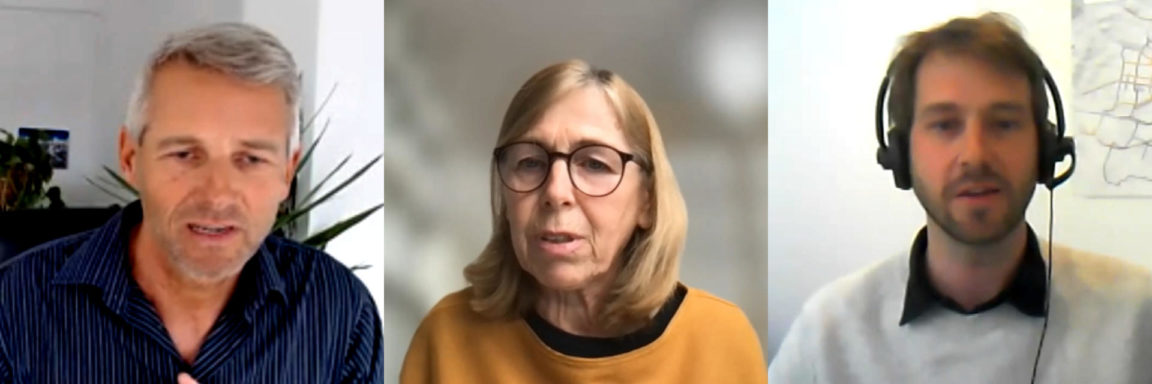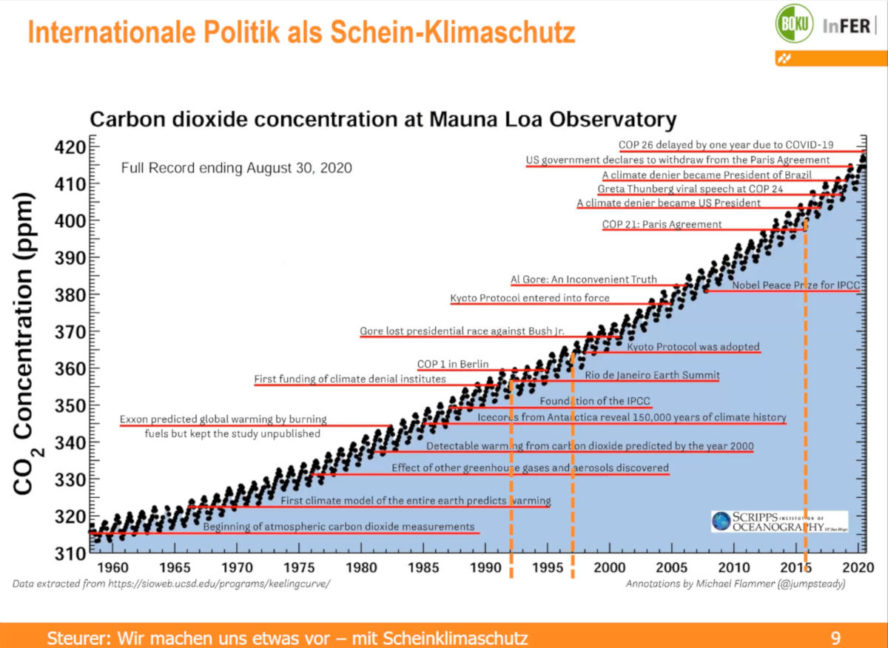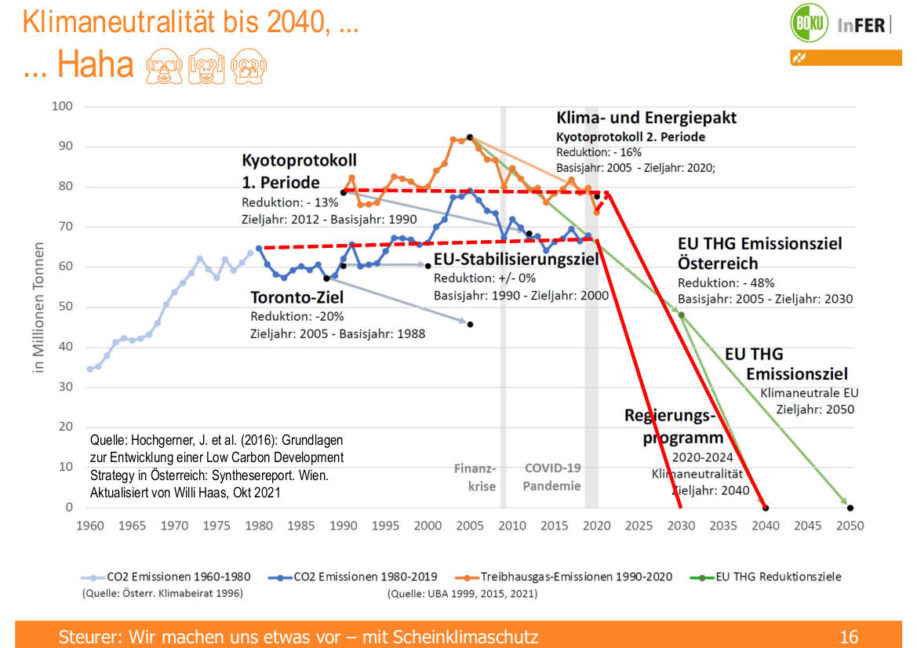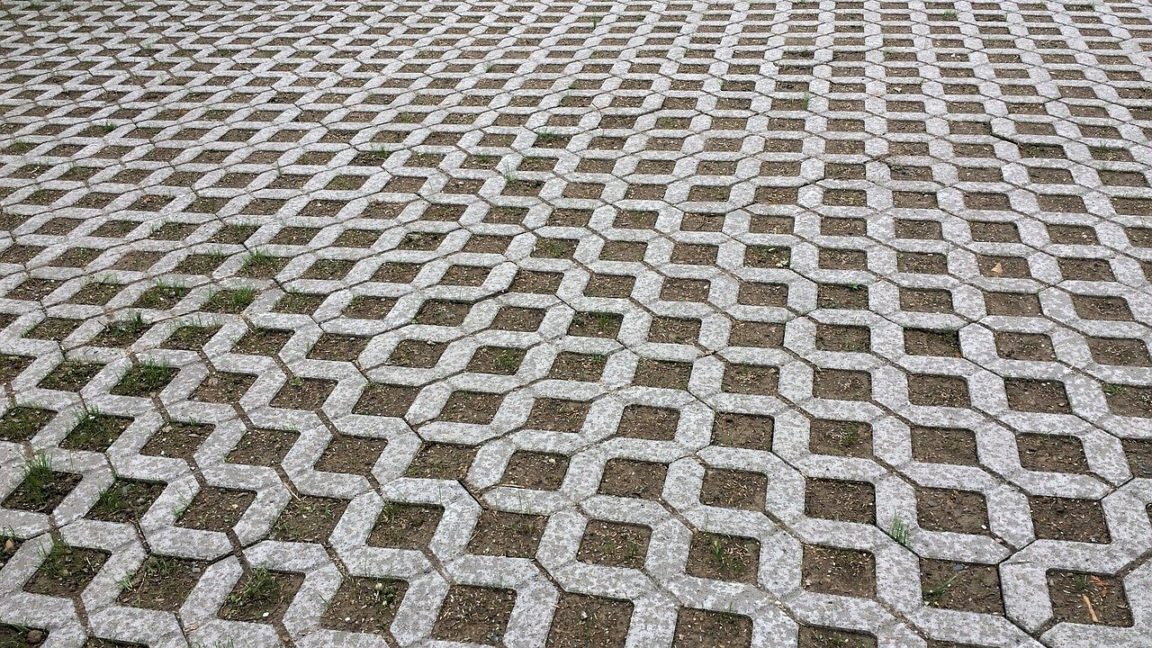by Martin Auer
Everyone protects the climate – but emissions are not going down. On April 27.4.2022, XNUMX, three experts spoke about this mysterious phenomenon at a press conference by Scientists for Future and the science network Discourse. Their conclusion: There is more fake climate protection in Austria than real .
Renate Christ: Individual measures are not enough
Renate Christ, long-serving Secretary General of the Intergovernmental Panel on Climate Change (IPCC), explained the framework conditions for effective climate protection: First: In order to stabilize the global average temperature at a certain level, CO2 emissions must be reduced to net zero. Otherwise, the temperature will continue to rise. For the 1,5°C target, net zero must be reached in the early 50s, for the 2°C target in the early 70s. Small emission reductions, small course corrections are simply not enough, what is needed is drastic and consistent decarbonization in all areas, not to mention a reduction in other greenhouse gases. In general, a reduction in energy and material consumption is required, and not just an increase in efficiency. Reducing consumption and increasing energy efficiency must happen at the same time. In summary, this means: sufficiency, efficiency and renewable energy, these are the three guiding principles.
Dangers lurk from "stranded investments", for example huge liquid gas terminals or a new gas boiler. Another danger is the "rebound effect", example: if the car consumes less fuel, people drive more often and further.
The last IPCC report emphasizes that the climate goals cannot be achieved through individual measures; a systemic approach is needed, a transformation in all areas: infrastructure, land use, architecture, production, transport, consumption, building renovation and so on.
Christ calls for clear political decisions and plans that are coordinated, both regulatory and economic measures. It needs both laws and taxes. The concept must be: "Avoid, shift, improve". She explains what is meant by this using the example of traffic: Firstly, avoid traffic by means of appropriate spatial and urban planning. Second: Shift to public transport or sharing offers and only last, as the third element, comes technical improvement. In this context, the e-car, when powered by CO2-neutral electricity, has the best decarbonization potential for motorized land transport. But we mustn't have the illusion that everything will be fine if we switch to e-authoring. Also problematic is the current trend in the e-car sector towards luxury class and SUVs, which is being reinforced by our subsidies. Large e-cars need more energy to operate and manufacture, they also need larger parking spaces, so they use up more land, and generally stand in the way of the necessary change in behavior.
Fake climate protection: e-fuels
E-fuels, i.e. synthetic fuels, are often advertised as a substitute for fossil fuels, with the argument that they can be used in conventional engines and heating systems. However, the production of e-fuels, but also of hydrogen, requires a multiple of the energy compared to the direct use of electricity to operate a car or a heat pump, i.e. also a multiple of wind turbines, PV panels, hydroelectric power plants, etc. There is a There is a risk that electricity from coal-fired power plants will be used to produce e-fuels. This would drive out the devil with the Beelzebub.
Fake climate protection: Bio-Fuels
Bio fuels are also often touted as an alternative. What matters here is sustainable production, i.e. whether there is a conflict with food production or, for example, with the land rights of indigenous peoples. You also have to ask yourself whether, in times of grain shortages caused by the war in Ukraine, it is ethically justifiable for biofuel made from grain to go into our tanks. E-fuels and bio-fuels play an important role in areas where there is no alternative, i.e. certain industries and shipping and aviation.
Fake climate protection: CO2 compensation
As a last example, Renate Christ cites CO2 compensation, which is very popular in air traffic but also in other areas such as e-commerce or CO2-neutral parcels. For a few extra euros you can finance a climate protection project - mainly in developing countries - and then think that in this way the flight would not cause any environmental damage. But that is a great fallacy. Compensation is necessary for a net zero target, but the potential for afforestation and also technical solutions is very limited. These “negative emissions” are badly needed to offset hard-to-avoid emissions from critical areas and cannot offset luxury emissions.
Reinhard Steurer: We're fooling ourselves
Reinhard Steurer, Professor of Climate Policy at BOKU Vienna, explained that we are simply deluding ourselves if we believe that we take climate protection seriously, individually, politically and in business. Many measures are not about solving the problem adequately, but about making us appear or feel better. The central question for recognizing bogus climate protection is twofold: How much does a measure actually reduce greenhouse gas pollution and to what extent does it only help to calm one's conscience?
Fake climate protection: Car-free Caribbean vacation in the Sustainable-Lifestyle_Resort
As an example, Steurer cites the “car-free Caribbean vacation in a sustainable lifestyle resort”. We regularly choose fake climate protection in the supermarket, such as in national council or state elections. In the political field, it's very much about show and symbolism. At the international level, we see a thirty-year history of climate policy that is in fact a history of climate crisis escalation. The Paris Agreement, says Steurer, is an agreement towards 2,7C to 3C with a 1,5C label. Despite all the conferences and agreements, the curve of the concentration of CO2 in the atmosphere has become steeper and steeper. It would have taken more to flatten the curve, for example a World Climate Organization analogous to the World Trade Organization, there should not have been free trade without climate protection and we should have introduced climate tariffs a long time ago.
Slide by Reinhard Steurer
For a long time, the EU emissions trading system was only sham climate protection because the CO2 price of 10 euros was too low. In the meantime, sham climate protection has turned into real climate protection. Another example is that in the EU, plastic waste incineration and biomass incineration are considered zero-emission renewable energy. Today, coal-fired power plants burn wood from the USA that comes from clear-cutting.
Steurer appeals to journalists never to accept political rhetoric without checking it. Merkel and Kurz, for example, have always praised their climate protection activities, but the empirical fact is that the years of government activity by the CDU and ÖVP have not brought any reliable results. Whether you deny the climate crisis or try to solve it with bogus climate protection, the result is the same: emissions are not coming down. Like other European parliaments, the Austrian parliament has declared a climate emergency. But where is the climate emergency policy? Even the climate protection law that Austria has had in recent years has been virtually ineffective.
Fake climate protection: climate neutrality by 2040
The ultimate bogus climate protection banter is the talk about the 1,5°C target and the talk about climate neutrality by 2040. That sounds good, but from today's perspective this goal is unattainable. So far all emission reduction targets have been missed, after the pandemic emissions have returned to previous levels, they have not been reduced since 1990. Carbon neutrality would mean that emissions must go to zero by 2030. That is de facto impossible with the politics that we see. You really have to cover your eyes and ears to keep this fairy tale alive.
Fake climate protection: green gas
Finally, Steurer mentions fake climate protection in the economy: "Whenever someone from the Chamber of Commerce tells you something about 'green gas', hydrogen in gas heating systems, in households, then that is simply a lie." We will need valuable hydrogen and biogas where there is no other alternative, for example in air travel.
False climate protection are buzzwords such as "climate protection with common sense" or the claim of the Chamber of Commerce to carry out climate protection only on a voluntary basis, without bans and tax mechanisms. The Chamber of Commerce even boasts that it negotiated away the abolition of the diesel privilege.
Adults used to tell children fairy tales, says Steurer. Today the children of Fridays for Future explain the climate crisis to the adults and the adults tell each other fairy tales.
The Greens also practice fake climate protection, for example when the Ministry of the Environment boasts that the signs that ASFINAG put up along the motorways are made of wood, and when it is not clearly and unambiguously shown that the current policy does not meet the goals for 2030 and 2040 are not available.
Almost every measure contains the potential for substantial changes, but also the potential for climate protection. It is about recognizing and uncovering false climate protection, because then it no longer works.
Ulrich Leth: Traffic emissions are increasing instead of decreasing
Traffic expert Ulrich Leth pointed out that traffic is primarily responsible for the stagnation in emissions. 30 percent of emissions in Austria come from this area. While emissions have fallen in other sectors, they have increased by 30 percent in transport over the past 75 years.
Fake climate protection: climate-friendly parking spaces
Here, we encounter bogus climate protection in various forms. For example, "climate-friendly parking spaces" were anchored in the Lower Austrian housing promotion scheme. The unsealing of parking spaces is intended to counteract the summer heat. Sounds good, but the problem is that the parking lot itself is the most important source of traffic because parking lots are the source and destination of car traffic. As long as a minimum number of parking spaces is prescribed - and this is a relic of the Reichsgaragen regulation in the "Third Reich", where mass motorization was the declared goal - as long as the unsealing of parking spaces is only a green coat of paint for an infrastructure that further promotes the use of cars . And that is independent of the drive type of the car, because the urban sprawl potential of car traffic with all the negative consequences such as land consumption and segregation of use remains the same.
Fake climate protection: climate protection through motorway construction
The next example is “Climate protection through motorway construction”. Here one hears that projects such as the Lobau Tunnel would enable climate-friendly urban development. But the original reports clearly show that this project would give impetus to urban sprawl and create another suburb of shopping centers and specialist markets on the outskirts. The radial road network would be more heavily loaded and the Marchfeld landscape would be cut up. Nothing has changed in the foreseeable effects, only the rhetoric has changed.
Of course, it is also fake climate protection if you try to make emission-promoting projects appear climate-friendly: renaming a motorway a city street has nothing to do with climate protection.
Fake climate protection: fluid car traffic
You often hear that car traffic has to flow so that as little exhaust gas as possible is emitted. Inner-city "green waves" are required or the expansion of interurban roads. It is said that the smoother car traffic, the better for the climate. But that too is a bogus climate protection argument. Because if car traffic becomes more fluid, it will also become more attractive, and people will switch from other means of transport to the car. There are enough examples of this: the "Tangente" in Vienna was originally intended to relieve the inner-city streets, it is still overloaded despite successive widening. The S1, the relief road of the relief road, is now overloaded and has generated thousands of additional journeys per day.
Fake climate protection: "Mega cycle path offensive"
It is also sham climate protection to do far too little of the right thing. On closer inspection, the City of Vienna's “mega cycle path offensive” turns out to be a fraudulent label. 17 kilometers of new cycle paths are to come. But that is partly due to insufficient cycling infrastructure, for example that cycling is guided on a bus lane. Of the 17 kilometers that have been announced, there are only just over five that are really new cycle paths. The gaps in Vienna's main cycle path network are 250 kilometers. With five kilometers per year, it will still take a few decades until there is a continuous, coherent network of cycle paths.
What would actually be climate protection in the transport sector? Car traffic would have to be drastically restricted, so that only distances would be covered by car where it really isn't possible any other way. This applies, for example, to heavy goods transport or emergency vehicles.
Parking space management is a positive example of how actual climate protection can work, because it really starts at the source of the paths.
The alternatives to the car must be massively expanded. Public transport must become simpler, cheaper and more reliable. Walking and cycling must be encouraged. Wider sidewalks without obstacles are needed, crossings must be made safe for pedestrians, cycle lanes are needed on all main streets. A good quality indicator would be whether a XNUMX-year-old girl can cycle to school on her own.
Cover photo: Montage by Martin Auer
This post was created by the Option Community. Join in and post your message!








